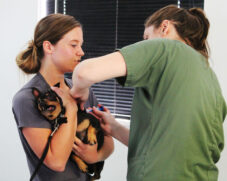(Editor’s note: This is the last of the four-part series about the crisis at the Valencia County Animal Shelter. The series includes articles about successful adoptions, rescue group efforts, overcrowding and euthanasia rates and the ongoing struggle toward the solution.)

During a recent pet health fair at the Valencia County Animal Shelter, Donna Stumpf, executive director of Animal Humane New Mexico, holds a resident’s dog. Animal Humane is one of several nonprofits that regularly helps the shelter host clinics and other events for the community.
Julia M. Dendinger | News-Bulletin photo
It’s been said you can get by with a little help from your friends.
For years, if not decades, the Valencia County Animal Shelter has relied heavily on friends and strangers to make up the gaps.
Everything from bottles of bleach to kitten formula to veterinarian care has been, to some extent, supported by donations and good will.
From Animal Humane New Mexico helping to coordinate a $5 pet health fair to microchip and vaccinate pets to Rocky Mountain Puppy Rescue sending a team down from Aurora, Colo., to spay and neuter hundreds of local animals, VCAS has worked to do all it can with what it has.
With a budget of almost $850,000 this year, some might think the shelter wouldn’t need outside help, but Valencia County Animal Control Director Jess Weston points out more than half of that goes to staff salaries and benefits.
“That’s right off the top, then you have things like vehicle maintenance, vet care, cleaning supplies, food for the animals,” Weston said. “It doesn’t go as far as it sounds like.”
With intake numbers in the thousands every year — 5,136 in 2018 and 4,131 in the first nine months of 2019 — the shelter struggles to get animals out the doors and into permanent homes and rescues. The more than 1,500 animals a year that are transferred to other shelters helps as well, but the ultimate goal is to stem the intake tide. And this might be the year the tide turns.
During the 2019 Legislative session, Weston made a plea — help fund a spay and neuter program in Valencia County. Officials listened, and in April, funding in two bills totaling $595,000 and spanning two fiscal years, was awarded to the county for just that purpose.
Senate Bill 536 allocated $200,000 from the general fund and House Bill 548 pulled another $145,000 to equip and operate a spay and neuter clinic and program in Valencia County. Those funds can be spent in the 2019 and 2020 fiscal years.
The bills also set aside separate allocations for next fiscal year, 2020, of $75,000 and $175,000, respectively.
Since the money didn’t come through the state’s annual capital outlay bill, it can be used in a variety of ways — from purchasing equipment and consumables for the clinic to hiring a veterinarian and vet tech to staff the program.
While the money has been allocated, Weston is still waiting on direction and a contract from the state’s Department of Finance and Administration, the agency that will handle the disbursement of the funds.

Madison Beets holds tight to Bruno, while Natalie Wilson administers a shot during a recent pet health fair held at the Valencia County Animal Shelter, in partnership with Animal Humane New Mexico. About 200 dogs and cats received vaccinations and microchips that day.
Julia M. Dendinger | News-Bulletin photo
“We are getting quotes for supplies, equipment, the consumables like sutures, and we have put together a job description for the vet and vet tech,” Weston said. “Now we’re waiting to get approval from DFA.”
At this point, the director said he isn’t sure if the new position would be an in-house hire or a contract employee.
“Either way, the ultimate goal is to have a system where people can make an appointment to bring in their own animal and we can take care of animals we already have in the shelter as well,” he said.
Weston said a fee schedule for spay and neuter procedures for residents hasn’t been established, but when it is, the intent is to keep it as affordable as possible.
When the shelter holds a low- or no-cost spay and neuter clinic, the spaces are limited to a couple hundred in a two-day span at most, but there are always dozens of residents left on waiting lists until the next clinic.
Pinning down one reason for the large number of unsterilized animals in the county is difficult.
“Some might be that we are, historically, a farming and outdoor kind of community. Before things became so built up, contact between dogs was few and far between,” he said. “There are income reasons. People have different priorities and cultural approaches. If you ask 100 people, you’ll have 100 different reasons.
“We have to ask how, as animal control, can we come up with solutions. We know the results. We just don’t always know why.”
While offering a low-cost spay and neuter program will go a long way, Weston said educating the public about being good animal owners is also key.
“Getting people to be responsible. Just because you keep a dog outside doesn’t mean you’re a bad pet owner,” he said. “But you have to make sure they’re taken care of, have water, food, shelter and vet care. A spay/neuter program will be a huge opportunity for residents. Once it’s up and running, we hope they take advantage.”
Dr. Florian Sanchez, the veterinarian at Yucca Veterinary Medical Center in Belen, said spaying and neutering pets is beneficial, but more important than that is awareness and education.
“Awareness brings personal responsibility. People should be aware that a female can go into heat twice a year,” Sanchez said. “People should know they can start breeding anywhere from 4 1/2 to 8 months old. If you don’t plan to have your animal spayed, then you need to be responsible.”
Sanchez said he understands cost could sometimes be a hurdle for those wanting to have their animal spayed or neutered.
“But there are a lot of programs out there and price discounts to take advantage of,” he said. “It’s about your personal priorities.”
Sanchez is one of the local veterinarians who works with Zimmer Feline Foundation, which provides free spay/neuter vouchers for low-income caregivers of companion cats. He hasn’t connected with an organization that provides the same type of services for dogs.
“I just try to stay affordable,” he said.
Shelter transport coordinator Patty Mugan said being a pet owner is a lot of work.
“People have to remember, you have to teach them like kids, spend time with them,” Mugan said. “I remember one time we had someone adopt a dog and brought it back two hours later. The apartment they lived in didn’t allow pets. Come on, you know the rules where you live. Be aware, be prepared to do the work.”
Mugan, who began working at the shelter as a volunteer a decade ago, said community events such as the shot and spay and neuter clinics are a lot of work, but always well worth the effort.
“There’s a lot of things the public doesn’t see. We have to schedule and reschedule events behind the scenes, sometimes multiple times, if we can’t find a vet for the event,” she said. “We want to do more events and we could if we have more participation from our local providers.”
Sanchez said volunteering for community events, such as spay and neuter clinics for the county shelter was difficult, especially since he is a one-doctor practice.
“In the future, if I have more doctors, I’d probably be more willing,” he said. “It’s hard to do the day-to-day appointments, plus emergencies, then do a volume event like that.”
This year, Weston marks his third year as the county animal control director. When he started, he told the shelter staff, “We can’t save everything but we have to try.”
He still believes in that.
“We’re not in this business because we don’t like animals. I — we — love what we do,” he said. “If we can save one animal, that’s a good day.”
Julia M. Dendinger began working at the VCNB in 2006. She covers Valencia County government, Belen Consolidated Schools and the village of Bosque Farms. She is a member of the Society of Professional Journalists Rio Grande chapter’s board of directors.
















